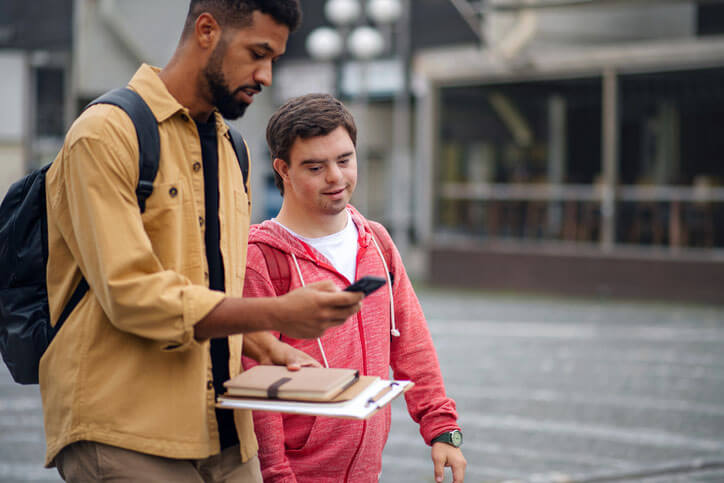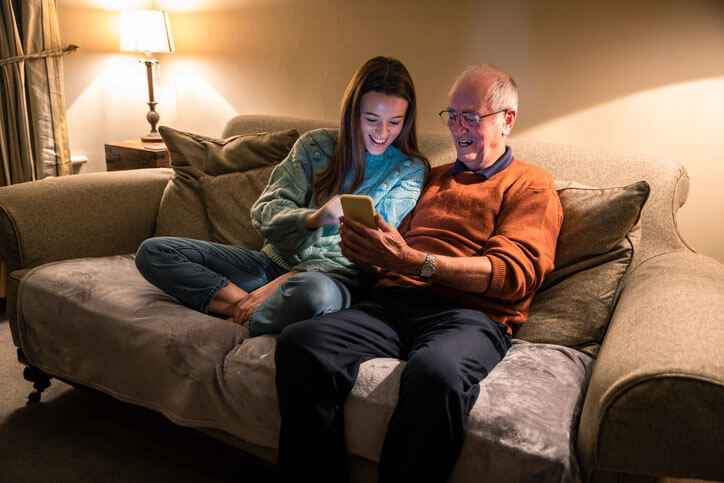
It’s homeroom on Monday morning. Your classmates are idly chatting as they wait for the bell to ring. You’re groggy and not really in the mood to talk. But the student next to you (who you’ve never really talked to before) comments on the sticker on your binder. You got it at a show for your favorite band. In the seconds before morning announcements, you discover your classmate really likes the band, too. You feel energized, connected, and warmed up. You’re ready to face the day and may have even found a new friend.
According to experienced special education instructor and researcher Professor Kharon Grimmet of Purdue University, students with disabilities don’t often have these kinds of interactions. “If I asked you what you did last weekend, you could tell me,” she says. “But that individual with an intellectual disability may not be able to.”
In fact, a 2021 study published in the Disability and Health Journal found that social isolation isn’t just common amongst people with disabilities — it can contribute to an overall lower quality of life. And because of their struggles with communication, many people with disabilities can’t share this hardship. It’s the very definition of a vicious cycle.
This troubling reality inspired Dr. Grimmet to craft a unique research project that would both offer a glimpse into the lives of people with intellectual disabilities and allow them a chance to tell their own stories. And it all started with asking special education students to do something their peers do every day: take pictures with a smartphone.
 In her over 20-year-long career, Professor Kharon Grimmet has been a special and general education teacher, a clinical associate professor, and now a Program Coordinator for Purdue University’s Special Education online degree program. Her many research endeavors focus heavily on enabling people with intellectual disabilities to share their perspectives on their own quality of life. Though this article covers her work with photo elicitation, she has also explored how music therapy can have a positive impact on autistic children’s social skills. In every aspect of her life’s work, Professor Grimmet champions inclusion and battles bias against people with disabilities.
In her over 20-year-long career, Professor Kharon Grimmet has been a special and general education teacher, a clinical associate professor, and now a Program Coordinator for Purdue University’s Special Education online degree program. Her many research endeavors focus heavily on enabling people with intellectual disabilities to share their perspectives on their own quality of life. Though this article covers her work with photo elicitation, she has also explored how music therapy can have a positive impact on autistic children’s social skills. In every aspect of her life’s work, Professor Grimmet champions inclusion and battles bias against people with disabilities.
Professor Grimmet’s Study: An Exercise in Photo Elicitation and Deep Conversation
In a summary of her research project, Professor Grimmet writes that her goal was to discover, “the perspectives of individuals with intellectual disability on their quality of life.” However, she also notes that these individuals often struggle with basic communication skills. Verbal interview techniques weren’t likely to be productive. Instead, she looked to a sociological interview method called photo elicitation.
Photo elicitation is the act of using a visual medium like photographs as a launching pad for discussion in interviews. In many cases, interviewees take the pictures themselves. This allows the interviewer to discern the interviewee’s attitudes about their photography subjects and explore more complicated yet related topics. Often, photo elicitation is used to breach difficult emotional subjects or intangible ideas
For Professor Grimmet, arming special education students with smartphones was the most logical and accessible way to elicit her students’ perspectives on life:
“I gave all of my learners an iPhone because our iPhones are an amazing, socially appropriate way to communicate. Everyone takes photos, we take selfies, we take photos of places we go, and people we’re with. I wanted my learners to take pictures of what they were doing and who they are.”
The idea worked wonderfully. The study’s participants shared specific aspects of their lives with Professor Grimmet. They talked about things like weekend activities, hobbies, and family traditions with newfound enthusiasm and clarity. Using their own pictures as conversational aids made it all possible.

But Professor Grimmet was especially delighted to find that photo elicitation allowed the students to hold nuanced conversations. Even though each picture captured a specific moment or object, they prompted students to talk about their own unique perspectives:
“Every participant was so unique and they had thoughts, they had ideas, but nobody has ever asked them to share them before. It was really eye-opening to be able to tell their stories and to share that.”
For instance, one participant who lives in a group home was able to express the idea that as an adult, he should be able to choose what he eats. In conversations like that, Professor Grimmet and her students got exactly what they wanted. They got to talk about life and develop meaningful bonds.
Empowering Self-advocates
Because of their struggles with communication, being ignored is a fact of life for many people with disabilities. And unfortunately, it happens in some surprising settings.
For example, in a survey of over 700 American physicians, only about 41% said they feel confident that they can provide the same level of care to patients with disabilities as those without. Only about 57% said they strongly agreed that they’re welcoming to patients with disabilities. Similar attitudes can be found in education, the workforce, and the world at large.
But as Professor Grimmet’s groundbreaking photo elicitation work shows, not being able to communicate in a traditional way isn’t the same thing as having nothing to say:
“They want to be a part of society. They want jobs, they want to be independent, they want all of the things that you and I want. It’s our duty and our job to listen and to teach them how to advocate for themselves.”
That’s exactly why Professor Grimmet’s work is so important. As she points out, smartphones are ubiquitous and snapping pictures with them is a socially normative activity. But through this commonplace technology, people with disabilities can communicate with doctors, teachers, employers, and others who make assumptions about their abilities and inner lives. They can find their voices and use them to, as Professor Grimmet so passionately puts it, “share their hopes, their dreams, their wants, their wishes, their feelings, and their emotions.”
Building Stronger Schools and a More Connected Society
Even though Professor Grimmet’s study was focused on intellectual disability and special education, she thinks photo elicitation can be a powerful tool in all types of learning environments:
“I would love to see teachers use photo elicitation especially in the beginning of the year and just get to know their learners, to allow their learners to share with one another and to really develop this classroom environment. We can get to know each other’s different cultures and the things that make us beautiful and unique.”
This level of understanding can transform classrooms into safe, equitable spaces where students won’t stifle questions out of embarrassment or a lack of motivation. They can see their teachers as trusted stewards of knowledge who actually know and care about them. As a 2019 research review published in the Journal of Education and Practice points out, strong student-teacher bonds have been proven time and time again to improve student outcomes on academic and personal levels. In this trust-based context, students don’t just absorb information. They become curious lifelong learners.
However, the significance of Professor Grimmet’s work doesn’t end at the classroom door. She thinks students can use photo elicitation at home to tell family members what they learned that day, effectively encoding information and making education a community affair:
“It allows that learner with or without a disability to be able to articulate, ‘This is what we did today, and here’s why we did it.’ If you think about it, that’s a high level of learning. That demonstrates understanding and comprehension.”
Implications for Teacher Development and Future Research
Today, Professor Grimmet uses her research and teaching experience to inform the development of Purdue University’s Special Education online degree program. As Program Coordinator, she wants her students to walk away with more than a headful of regulations and facts about various intellectual disabilities:
When I think of how it all comes together and has made me who I am, but also as I’ve developed this program, I think the word ‘intentional’ is what I would say. We have to be intentional from the get-go. You’re learning the why behind what we do.
Professor Grimmet and her colleagues are forming special educators with a stewardship mindset. They’re equipping them to actually serve and empower students who are often shushed by the outside world.
And with that intentional approach to educator development, the Professor’s photo elicitation work could be the beginning of a new era for special education and disability research. What other assumptions about people with disabilities can be proven wrong? If smartphone cameras can do so much, what other technologies can be used to make a more inclusive world? The answers may be hidden for now, but when impassioned researchers like Professor Grimmet take the time to get input from the often ignored people they serve, the future is sure to be bright, inclusive, and full of possibilities.


